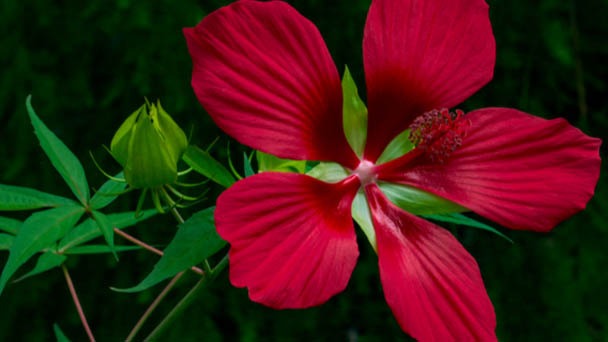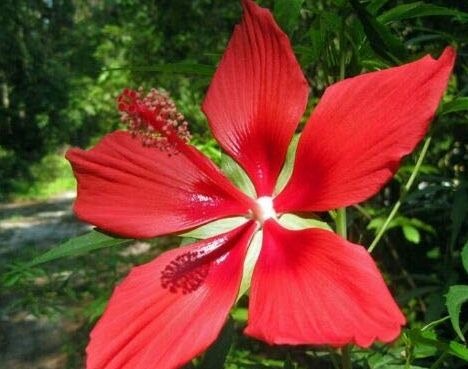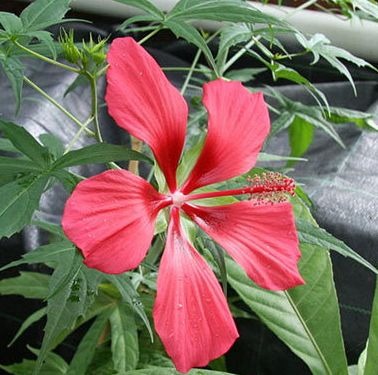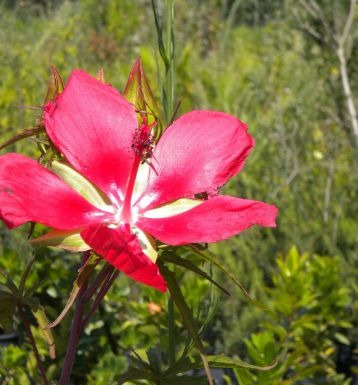Texas Star Hibiscus Plants - How to Grow & Care for Scarlet Rosemallow
Written by Ivy
Feb 10 2023

The Texas star hibiscus is a low-maintenance plant that is perfect for amateur gardeners. The Texas star hibiscus is a plant that we'll talk about growing and caring for in this article.
Although Texas Star Hibiscus can be grown in a variety of soils, they favor a moist, well-drained soil. They flower best in direct sunlight and with regular watering. They can even be grown in a pond in your backyard. Winter causes the plants to wither to the ground, but late spring brings them back with sprouts. They develop quickly and don't need much attention. In the spring, lightly prune any leggy stalks to shape them. In the winter, lightly mulch any plants that are not in a pond. Plant seeds in the early spring at a depth of ¼ inch; if kept moist, they will grow into plants that bloom their first year. The clump can be divided in the late winter and planted 2 to 3 feet apart with the crowns 3 to 4 inches below the soil.
Texas Star Hibiscus Care

Proper Location
The most crucial step in growing the Texas star hibiscus is selecting the ideal location for planting it. A location in your garden with moist, well-drained soil and no debris is advised. The scarlet hibiscus can grow in soil that is perpetually moist.
Read More: Why Do My Hibiscus Leaves Turn Yellow - Should I Cut Off Them
Size & Growth
The stems of scarlet hibiscus can reach heights of 3 to 6 feet and a width of 2 to 3 feet when grown in ideal conditions.
The Texas star produces palmately compound, foliage that resembles hemp throughout the growing season.
Deep green leaves are 5" – 6" inches wide, contrasting beautifully with the large red flowers.
Flowering and Fragrance
The scarlet rose mallow blooms profusely from June to September.
The large flowers are 5-petaled and approximately 3" – 5" inches in diameters and borne on the upper leaf axis.
Amateur gardeners adore these Texas star blooms for their distinctive appearance.
They produce delicious nectar, which attracts bees and other pollinators.
Light & Temperature
The plant thrives in full sunlight when grown in enriched wet soils.
The Texas star can also tolerate some light or partial shade, particularly in the spring and summer when the weather is particularly hot and dry.
Scarlet hibiscus are hardy in USDA Hardiness Zones 5 through 10, and they wither to the ground in the winter before regrowing in the spring.
When given enough mulch, some plants could, however, withstand USDA Zone 6.
Watering and Feeding
The Texas celebrity adores water. In temperate climates, provide 1" – 3" inches of water in a week.
Even though the plant is tolerant of summer heat and humidity, increase the amount if the summers are particularly hot and dry.
During the growing seasons—spring and summer—feed plants once a month.
For healthy new growth, apply a balanced fertilizer blend at the lowest monthly rate recommended on the package.
Soil & Transplanting
Garden soils with exceptional moisture retention are ideal for the plant's growth.
Use a typical, medium-to-wet soil blend with good drainage.
As a result, root rot brought on by excessively wet soils will be reduced.
The Texas star transplant did well.
Select a moist location in the garden for the transplanted swamp native, and add mulch and compost when you are planting it.
The Texas star hibiscus can grow in most types of soil, but it prefers swampy areas. To keep the soil moist, you must make sure to water your plant frequently. You should also check the PH of the soil if you want a healthy plant. For this plant, acidic to mildly acidic PH levels are ideal.
Grooming and Maintenance
With a few simple considerations, these plants require relatively little maintenance.
In windy and wet weather, Hibiscus Texas stars may need to be staked.
When it comes to pruning, cut the plant back to the ground in the early winter.
If the cold doesn't kill the plant, cut the plant's height in half in the late winter to manage its size.
Also, protect the plant tops with a 5" inch layer of mulch.

How to Propagate Hibiscus Coccineus
Texas star hibiscus is widely available in commerce, but it is also very simple to grow new plants from seeds.
Once the last frost has passed and early spring has arrived, gather the seeds and plant them in the ground.
After the seed pods have dried on the plant, hibiscus seeds should be harvested.
Plants should be started indoors, and when seedlings are long and sturdy enough to handle, they should be transplanted.
propagate as well using cuttings from the stem and tips.
How to Plant Texas Star Hibiscus Seeds
Hardy hibiscus seedlings like the Texas Star will require cold stratification, which deceives seeds into entering a dormant state that is necessary for germination.
Place the seeds in a moisture-proof container outside, where they will be exposed to winter temperatures, in order to stratify them in the fall or winter. Alternatively, store dry seeds in the fridge for 60 to 90 days in a container or package that is tightly sealed. Some claim that if you don't have much time, you can try freezing the seeds in a moisture-proof container for a few days. Allow the seeds to thaw after stratification is finished.
The next action you must take is referred to as scarification. Texas Star Hibiscus seeds, like okra and beet seeds, have a hard outer shell that, if submerged in water overnight or gently scarred, can aid in germination rates.
Hibiscus Rose Mallow Pest Or Diseases
Grasshoppers are known to be attracted to swamp hibiscus. The foliage and flower buds are attacked and eaten by them.
You can either manually remove these with your hands or find a solution at a nearby nursery.
The plants are also prone to ailments like leaf spots, rust, canker, and blight.
Aphids, Hibiscus whiteflies, and Japanese beetles should also be on the lookout for.
Texas Star Hibiscus Uses
The huge flowers on H. coccineus are what make them popular in the garden.
The plants are substantial enough to fit along perennial borders and at the back of flower beds.
Texas hibiscus looks gorgeous in courtyards and mixed borders.
They could also be grouped together in wet, marshy areas near pond or stream edges.
Gather the flowers while they are in bloom and use them in bouquets with other wildflowers.
The pollen-filled blooms also serve as pollinator beacons.
It is an excellent addition to pollinator gardens because bees, hummingbirds, and other insects frequently buzz around it.

Texas Star Hibiscus Growth and Care: Conclusion
The Texas star hibiscus is not difficult to grow, cultivate, or care for, as you can see. Hibiscus coccineus is low-maintenance and blooms beautiful bright scarlet flowers that will dramatically improve your garden or indoor spaces when potted. Follow this advice and try out this plant if you're unsure about your green hand.
FAQs
Is Texas Star Hibiscus Poisonous
Children, toddlers, and babies shouldn't be around the plant because neither the leaves nor the flowers of the hibiscus are poisonous to humans.
Texas Star Hibiscus Cold Tolerance
Although it will die back to the ground and reappear in the spring in colder areas, sometimes as cold as zone 5, it is hardy in USDA zones 8 to 11.
What's the Height Texas Star Hibiscus
It typically grows to be 4-6 feet tall and 3-4 feet wide, but it can get bigger. Due to the Texas Star Hibiscus' deciduous nature, its leaves fall off each year in the autumn. You can trim it back to within 4-6 inches of the ground once all the leaves have been removed.
Latest Updated
- Texas Star Hibiscus Plants - How to Grow & Care for Scarlet Rosemallow
- Hibiscus Mutabilis (Confederate Rose) Grow & Care Guide
- Why Do My Hibiscus Leaves Turn Yellow - Should I Cut Off Them
- Peace Lily Root Rot - Signs & How to Treat
- Why Is My Peace Lily Not Blooming - Causes & How to Get Them Bloom
- How Long Do Peace Lilies Last - How to Make Them Live Longer
- Peace Lily Drooping & Keep Wilting - How to Save It
- Are Peace Lily Plants Toxic to Cats - What Part is Poisonous
- Why Do My Peace Lily Leaves Tips Turn Brown - Common Reasons
- 12 Amazing Peace Lily Benefits to Keep Your Garden Fresh!
Popular Articles
- Winter maintenance of Antirrhinum Majus
- How to Grow Terminalia Mantaly Tree
- How to Grow and Care for Crossostephium Chinense
- How to grow Antirrhinum Majus in spring
- Peristeria Elata (Dove Orchid) Profile: Info & Care Guide
- Underwatered Snake Plant (Sansevieria Trifasciata) - Signs And How To Fix
- How to Care for Brazilian Jasmine Plant (Mandevilla Sanderi)
- Rosa Chinensis (China Rose): Plant Growing & Care Tips
- How to Grow & Care for Graptopetalum Purple Delight in Summer
- How to Care for Baby Sun Rose (Aptenia Cordifolia)